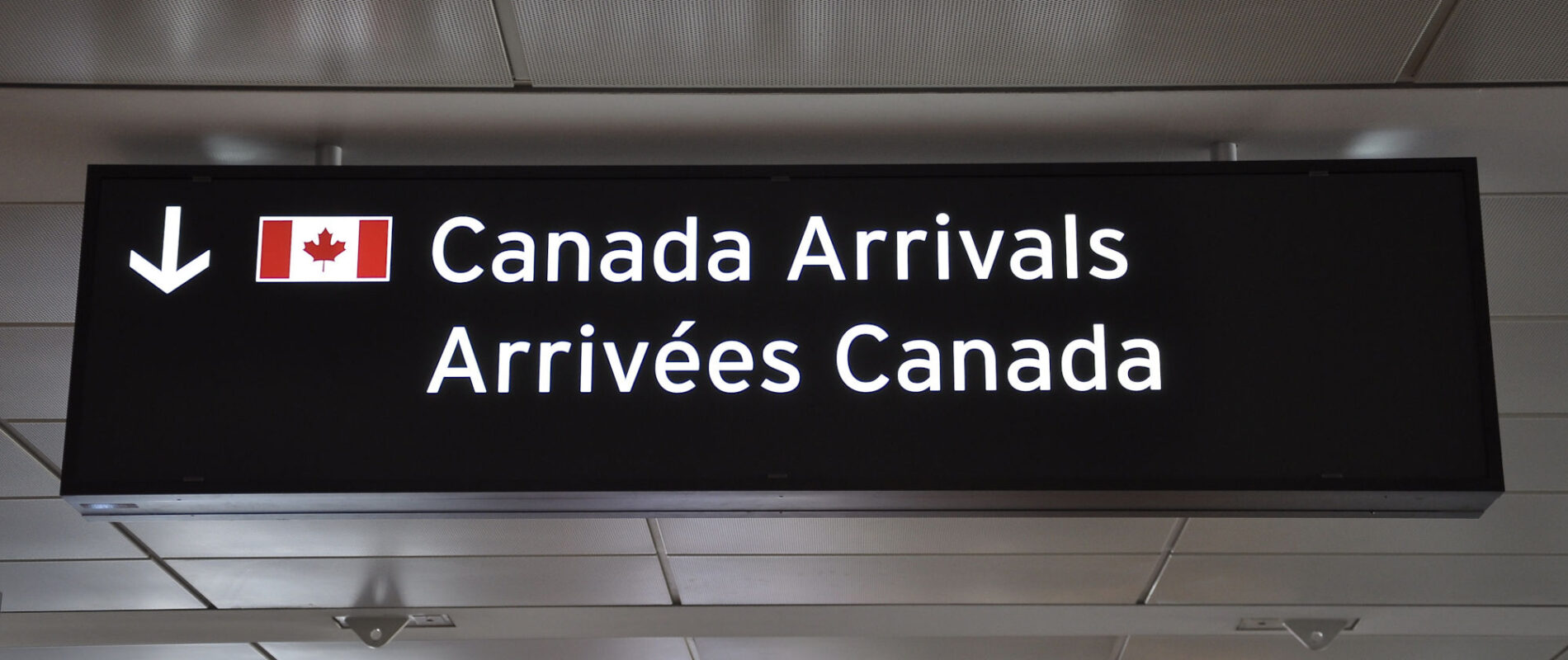Arriving in Canada and going through immigration to activate your Working Holiday permit can be stressful and we get a lot of questions about this step. What should you remember to bring? What does the Working Holiday permit activation process involve, exactly? What should you look for on your work permit?
Here are a few tips to help you avoid mistakes, so you can get your Working Holiday permit without a hitch.
1. Have all the necessary documents handy
The first step for a smooth permit activation is to make sure you have all the documents needed to activate your Working Holiday permit printed out and ready to show. These documents include:
- Your port of entry (POE) letter.
- Your Electronic Travel Authorization (eTA), required for travel to Canada by air. You can find this information on your POE letter. You don’t need to apply for a separate eTA, unless you’ve renewed your passport since applying for your Working Holiday permit (the eTA is linked to your passport). If in doubt, you can check your eTA status. However, eTAs listed on the POE letter don’t always show up in the system, so don’t panic if you can’t find the eTA from your POE letter in the system.
- Your passport, which must be valid for the duration of your stay. Your Working Holiday permit cannot go beyond the expiry date of your passport. If your passport expires during your working holiday, you can renew your passport while in Canada and apply for an extension on your permit expiry date. You must prove you entered the country with the right length of insurance to qualify for this extension (more on this below!). Whenever possible, it’s best to renew your passport in your home country before travelling to Canada to avoid the extra hassle.
- Your mandatory proof of insurance for the entire duration of your stay in Canada. You will be given a permit that expires when your insurance policy ends. For example, if you entitled to a 12-month Working Holiday permit, you must have coverage for these 12 months (or a 24-month policy for a two-year Working Holiday permit). If you only buy insurance coverage for six months, for instance, you will be issued a six-month Working Holiday permit. You won’t be able to extend your permit at a later date. Conversely, if you buy insurance coverage for 12 or 24 months but go home before the end of your policy, Globe WHV will refund the remaining months on your policy, as long as there are at least two months left on it.
- Proof of funds with at least CA$2,500 (or the equivalent in your local currency). A bank statement or a screenshot (less than 7 days old) of your banking app is accepted. This must be translated into English or French if your bank statement is in another language. If you’re travelling to Canada on a one-way ticket, you must prove you have CA$2,500 plus the price of a return ticket (a similar amount to the cost of your outward journey).
- Copies of the other supporting documents you supplied during the application process, such as your police certificate(s), proof of a medical exam, family information form, CV, etc. It’s unlikely you will be asked to show anything other than the POE letter, proof of funds, and proof of insurance, but you are still expected to have all the documents to hand in case a border services officer asks to see them.
Here’s another comprehensive checklist!
2. Check the expiry date of your medical exam results
This next point is only applicable to those who need a medical exam. If you weren’t asked to take a medical exam during the application process, skip to the next point!
You will only have to take a medical exam in a few specific cases, e.g. if you stated you want to work with children, if you’re from a country designated as high risk for tuberculosis, if you have a specific health condition, etc.
The medical exam results are valid for 12 months. Make sure you took the exam less than a year ago, otherwise you will be given a shortened permit that ends when the exam results expire. If you fail to activate your permit in time, you will need to take another medical exam before travelling to Canada.
The Government of Canada states the following:
“Your medical exam results are good for 12 months only. If you’re a student or worker, your letter of introduction shows the date your results expire.
If you don’t come to Canada as a visitor, student or worker within that time, you may need to do another exam.”
3. Don’t fly to Canada just before your POE letter expires
Don’t book a flight that arrives on the day before/the day of your POE letter expiring. Flight cancellations or delays do happen, and so do strikes, last-minute health issues, etc. It would be a shame to miss out on your Working Holiday adventure because your POE letter has just expired!
4. Plan for a long enough stopover
Your Working Holiday permit will be activated at the first port of entry in Canada. For instance, if you’re flying to Winnipeg with a stopover in Toronto, you will have to go through immigration and activate your Working Holiday permit in Toronto. Ordinarily, a two-hour stopover is enough time to catch a connecting flight to Winnipeg. However, you will be spending more time at immigration than the average traveller, so you must plan for a longer stopover.
This is particularly true if you’re travelling to Canada on a weekend or during holidays. Check the calendar for Canadian holidays, as airports can be packed around Thanksgiving or on the Labour Day long weekend!
5. Understand the travel declaration process
When you arrive in Canada, you will be directed to a primary inspection kiosk to fill out your travel declaration. All travellers go through this step, Canadian citizens and tourists alike.
Scan your passport, have your picture taken, verify your fingerprints and complete your declaration. It will be printed right away—bring it to the border services officer. For more info on the process, read How to use the kiosks.
You can also complete this in advance, using the Advance Declaration in the ArriveCAN app up to 72 hours before your flight. We recommend doing this to save time. You’ll still be sent to a kiosk to print off the answers you provided on the ArriveCAN app. If you’ve made any mistakes, you can change your answers at the kiosk.
6. Make sure to go through immigration
After receiving your printed travel declaration from the primary inspection kiosk, you will join the queue for passport control. Again, this queue is for everybody: workers, students, tourists, etc. Border services officers at this stage usually ask a few basic questions and check your passport. When they ask the purpose of your visit, explicitly state you’re coming to activate a Working Holiday permit.
You should then be directed to a separate section for immigration; often in a different room or office. Especially in the larger airports, you may have to join a long line! The border services officer here will call you up to a booth. They will take the time to review your documents and activate your Working Holiday permit.
Don’t skip this step and go straight to the luggage carrousel. You must go to the immigration office to activate your permit! If a border services officer does not direct you to the right place, ask a member of staff or keep an eye out for the immigration office.
7. Read your Working Holiday permit carefully before leaving the airport
Congrats, a border services officer has just issued your Working Holiday permit! It’s tempting after a long travel day, with nerves and excitement racing, to rush off to the luggage carrousel. However, you should take a few minutes while still in the immigration office to review your permit and make sure all the info is correct. Once you leave the immigration area, it will be a more painful process to ask for any changes.
Pay attention to:
- Your personal info (date of birth, spelling of names, etc.). If you spot a mistake, it’s easy to have it corrected right away with the border services officer in front of you.
- The permit expiry date. If you provided all the necessary documents (including a passport, proof of insurance valid for the entire duration of the work permit, proof of valid medical exam, if applicable, etc.), you shouldn’t be given a shortened permit. If there is an issue with the expiry date, ask them to correct it now. Otherwise, the application process for extending an incorrect expiry date takes a long time!
- The conditions. For example, if you did take a medical exam to work in healthcare or with children, make sure the condition “not authorized to work in childcare, primary/secondary school teachings, health service field occupations” has been removed. Again, the application process to change the conditions relating to a medical exam takes many months, so speak up!
Finally, don’t stress out too much about the arrivals process in Canada. As long as you know what to expect, your permit activation should go smoothly—and now you should feel well prepared.
















 Français
Français English
English




0 comments
{{like.username}}
Loading...
Load more